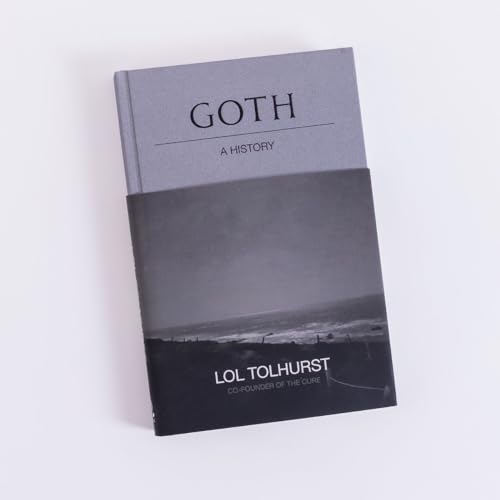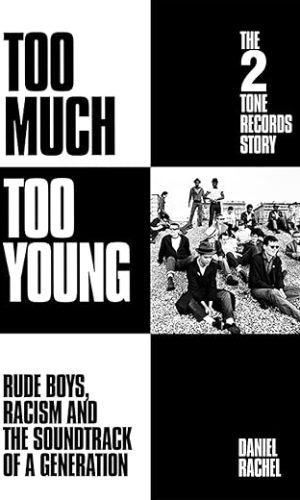Goth: A History
£19.00£23.80 (-20%)
Goth is an entertaining and evocative personal history of Goth music and culture, told by a true insider. Lol Tolhurst explores the godfathers of goth who established the genre’s roots – THE CURE, which he co-founded with Robert Smith, contemporaries SIOUXSIE AND THE BANSHEES, BAUHAUS, JOY DIVISION – plus many more great bands that offered a place of refuge for the misfits of the 80s and ever since.
Lol offers a fascinating deep dive into the movers and shakers of goth, imbued with his personal memories as well as those of fellow musicians, magicians and artists who make goth such an inevitable and enduring movement. Along the way he examines acts such as DEPECHE MODE and COCTEAU TWINS who helped the darkness expand. Finally, Tolhurst examines the legacy of goth music, and shows how its influence can still be seen to this day across music, film, TV, visual arts and social media.
As thoughtful and thorough as it is utterly bewitching, Goth is a timeless testament to why Goth matters – and why it always will.
Read more
Additional information
| Publisher | Quercus (21 Sept. 2023) |
|---|---|
| Language | English |
| Hardcover | 256 pages |
| ISBN-10 | 1529424275 |
| ISBN-13 | 978-1529424270 |
| Dimensions | 23.2 x 2.4 x 14.8 cm |











by Nicky
Could not wait to read this book.
by Ali
Goth: A History by Lol Tolhurst promises an inside look into the enigmatic and oft-misunderstood world of Goth music and culture. Tolhurst, best known for co-founding THE CURE, attempts to use his insider perspective to provide readers with a comprehensive overview of the genre’s evolution, key players, and its undying influence. However, while the book has its merits, it also leaves much to be desired.
The book’s strengths undeniably lie in its firsthand accounts. Being a pioneer of the movement, Tolhurst’s personal experiences and memories lend a unique authenticity to the narrative. His anecdotes about THE CURE, as well as interactions with other iconic bands such as SIOUXSIE AND THE BANSHEES and JOY DIVISION, offer readers an invaluable glimpse behind the curtain. These moments are where Tolhurst’s writing truly shines, allowing fans and newcomers alike to feel closer to the pulsating heart of Goth music.
Moreover, Tolhurst’s exploration of the influence of Goth culture on various art forms is commendable. By tracing its impact on music, film, TV, visual arts, and social media, he emphasizes the genre’s widespread and lasting significance. It’s a reminder that Goth isn’t just a musical subculture but a multifaceted movement that has seeped into various corners of popular culture.
However, this ambitious project is not without its flaws. One of the primary issues is the lack of depth in certain sections. While Tolhurst does an admirable job covering the early days of Goth and its foundational bands, his treatment of later acts, including DEPECHE MODE and COCTEAU TWINS, feels cursory at best. Given the profound influence of these bands on the expansion of the genre, a more in-depth analysis would have been both expected and appreciated.
Additionally, the book’s organization and structure occasionally hinder the reading experience. There are moments where the narrative becomes disjointed, with anecdotes and analyses seeming out of place. This sporadic approach makes it challenging to follow the genre’s chronological evolution, which can be particularly confusing for readers unfamiliar with Goth’s intricate history.
Furthermore, while personal experiences can add richness to a narrative, they can also introduce bias. At times, Tolhurst’s accounts lean heavily into his personal perspectives, which, although valid, might not provide the most objective overview of certain events or personalities. This subjective approach occasionally feels like a missed opportunity, especially when considering the potential breadth and depth of the subject matter.
Lastly, given his vast experience and intimate knowledge of the scene, I hoped for more insights into the socio-political environment that fostered the rise of Goth culture. Delving deeper into the societal factors and external influences that shaped the movement would have provided a richer, more layered understanding of its origins and evolution.
In conclusion, Goth: A History is a mixed bag. While it offers invaluable firsthand accounts and effectively highlights the genre’s influence, it falls short in terms of depth, organization, and objectivity. For dedicated fans of THE CURE or those seeking personal anecdotes from one of Goth’s key figures, this book may prove satisfying. However, readers looking for a comprehensive, unbiased, and structured history of the Goth movement might find themselves wanting more.
by Bookends
Having read John Robb’s History of Goth, and Cathi Unsworth’s Season of the Witch in recent months, the third Goth book on the conveyer belt landed on my doormat.
It’s by far my favourite of the three, not to say the other two were poor, just as a huge Cure fan, I loved reading Lol’s (own) version of the History of Goth, and all its strands that go to make Goth what it is.
It’s great to see that Lol has cleaned himself up, and found a career as a successful author as well as the other strings to his bow.
What with the recent two Wayne Hussey books, and now Lol’s second book, let’s hope either Siouxsie, Budgie or Steven Severin get round to writing their autobiographies about that brilliant period of music history that was 1977s -1988s Punk, Post-Punk, Goth heyday. Either of these three books would further improve this particular section of my music book collection.